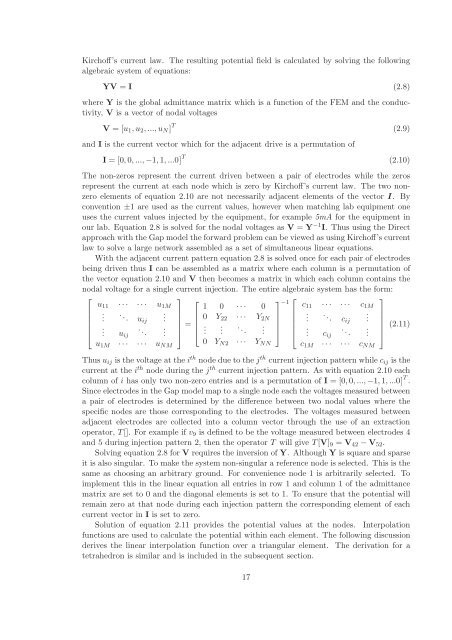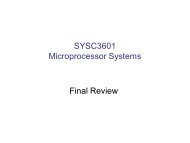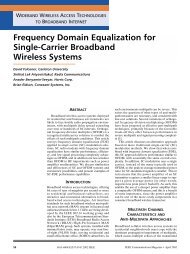Image Reconstruction for 3D Lung Imaging - Department of Systems ...
Image Reconstruction for 3D Lung Imaging - Department of Systems ...
Image Reconstruction for 3D Lung Imaging - Department of Systems ...
You also want an ePaper? Increase the reach of your titles
YUMPU automatically turns print PDFs into web optimized ePapers that Google loves.
Kirch<strong>of</strong>f’s current law. The resulting potential field is calculated by solving the following<br />
algebraic system <strong>of</strong> equations:<br />
YV = I (2.8)<br />
where Y is the global admittance matrix which is a function <strong>of</strong> the FEM and the conductivity,<br />
V is a vector <strong>of</strong> nodal voltages<br />
V = [u1,u2,...,uN] T<br />
and I is the current vector which <strong>for</strong> the adjacent drive is a permutation <strong>of</strong><br />
I = [0,0,..., −1,1,...0] T<br />
(2.9)<br />
(2.10)<br />
The non-zeros represent the current driven between a pair <strong>of</strong> electrodes while the zeros<br />
represent the current at each node which is zero by Kirch<strong>of</strong>f’s current law. The two nonzero<br />
elements <strong>of</strong> equation 2.10 are not necessarily adjacent elements <strong>of</strong> the vector I. By<br />
convention ±1 are used as the current values, however when matching lab equipment one<br />
uses the current values injected by the equipment, <strong>for</strong> example 5mA <strong>for</strong> the equipment in<br />
our lab. Equation 2.8 is solved <strong>for</strong> the nodal voltages as V = Y−1I. Thus using the Direct<br />
approach with the Gap model the <strong>for</strong>ward problem can be viewed as using Kirch<strong>of</strong>f’s current<br />
law to solve a large network assembled as a set <strong>of</strong> simultaneous linear equations.<br />
With the adjacent current pattern equation 2.8 is solved once <strong>for</strong> each pair <strong>of</strong> electrodes<br />
being driven thus I can be assembled as a matrix where each column is a permutation <strong>of</strong><br />
the vector equation 2.10 and V then becomes a matrix in which each column contains the<br />
nodal voltage <strong>for</strong> a single current injection. The entire algebraic system has the <strong>for</strong>m:<br />
⎡<br />
⎤<br />
u11 · · · · · · u1M<br />
⎢<br />
.<br />
⎢ . ..<br />
⎥<br />
uij . ⎥<br />
⎢<br />
⎣<br />
.<br />
. uij<br />
..<br />
⎥<br />
. ⎦ =<br />
⎡<br />
⎤−1<br />
1 0 · · · 0<br />
⎢ 0 Y22 · · · Y2N<br />
⎥<br />
⎢<br />
⎣<br />
.<br />
. . ..<br />
⎥<br />
. ⎦<br />
⎡<br />
⎤<br />
c11 · · · · · · c1M<br />
⎢<br />
.<br />
⎢ . ..<br />
⎥<br />
cij . ⎥<br />
⎢<br />
⎣<br />
.<br />
. cij<br />
..<br />
⎥<br />
. ⎦ (2.11)<br />
u1M · · · · · · uNM<br />
0 YN2 · · · YNN<br />
c1M · · · · · · cNM<br />
Thus uij is the voltage at the i th node due to the j th current injection pattern while cij is the<br />
current at the i th node during the j th current injection pattern. As with equation 2.10 each<br />
column <strong>of</strong> i has only two non-zero entries and is a permutation <strong>of</strong> I = [0,0,..., −1,1,...0] T .<br />
Since electrodes in the Gap model map to a single node each the voltages measured between<br />
a pair <strong>of</strong> electrodes is determined by the difference between two nodal values where the<br />
specific nodes are those corresponding to the electrodes. The voltages measured between<br />
adjacent electrodes are collected into a column vector through the use <strong>of</strong> an extraction<br />
operator, T[]. For example if v9 is defined to be the voltage measured between electrodes 4<br />
and 5 during injection pattern 2, then the operator T will give T[V]9 = V42 − V52.<br />
Solving equation 2.8 <strong>for</strong> V requires the inversion <strong>of</strong> Y. Although Y is square and sparse<br />
it is also singular. To make the system non-singular a reference node is selected. This is the<br />
same as choosing an arbitrary ground. For convenience node 1 is arbitrarily selected. To<br />
implement this in the linear equation all entries in row 1 and column 1 <strong>of</strong> the admittance<br />
matrix are set to 0 and the diagonal elements is set to 1. To ensure that the potential will<br />
remain zero at that node during each injection pattern the corresponding element <strong>of</strong> each<br />
current vector in I is set to zero.<br />
Solution <strong>of</strong> equation 2.11 provides the potential values at the nodes. Interpolation<br />
functions are used to calculate the potential within each element. The following discussion<br />
derives the linear interpolation function over a triangular element. The derivation <strong>for</strong> a<br />
tetrahedron is similar and is included in the subsequent section.<br />
17





